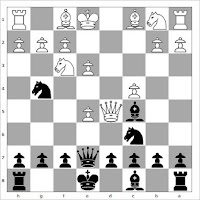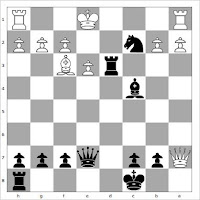The Budapest Gambit starts with 1.d4
Nf6 2.c4 e5!?

When gambits are played he/she wants them to be accepted. Accepting the gambit usually allows the Gambiteer to move the game into a prepared line of theory, where they know the tactics, strategy and traps. In many respects any player who declines the gambit is doing so to keep away from this preparation. It is therefore imperative that the Gambiteer is equally prepared in the declined as well as accepted lines.
The 2…e5 move forces White to decide whether to accept the gambit or decline the gambit.
If you are playing an opponent who knows of the BG or is of a relatively high rating they will most likely accept this gambit. However, not all of the BG games you play will be accepted gambits, some will be declined.
Declining the gambit gives Black equality through standard opening practice and in certain lines we can see Black gaining an advantage. Black will most likely have the first opportunity to castle, gain an equal control of the centre and good mobilisation of the pieces. In short, White loses the initiative.
White’s Options
We will now look at the options that White has when choosing to decline the gambit pawn. Each of these variations will be explained separately, but you will notice similarities between a number of them, e.g. castling kingside, the King’s Bishop moving to b4 or c5 and most importantly exd4 (where possible). This post concentrates solely on 3.Bg5 (with 4.Qxe4).
There are a number of options for White:
- 3.Bg5 – immediately pinning the knight
- 3.e3 - supporting the d4 pawn
- 3.Nf3 - supporting the d4 with a Knight
- 3.d5 - pushing the pawn.
Other options like 3.Be3 can be dismissed, for now, as they block pawns or development and simply taking the d4 pawn and developing naturally will give Black an advantage.
1.d4 Nf6 2.c4 e5 3.Bg5

The pin on the Black Knight threatens to weaken Black’s early control of the e4 square, but any exchange here would be better for Black as the game is likely to become open and beneficial to Bishops.
The pin should be met with the immediate pawn exchange
3...exd4
White has 2 sensible options. He can either choose to take the pawn immediately with 4.Qxd4 or develop first with 4.Nf3. We examine 4.Nf3 in our next blog!
Other variations, such as 4.Nbd2 or 4.g3 allow 4…Nc6 and the Pawn is difficult for White to win back.
4.Qxd4

White puts more pressure on the Knight at f6, but his Queen is out early and can be kicked off the d4 square whenever Black chooses.
4…Nc6

Immediately threatening the Queen, with a developing move, where a retreat gives Black a tempo.
After a retreat by White’s Queen the moves Be7, d6 and 0-0 will serve Black well, giving a solid playable position with open lines and an advantage in development.
We will examine 2 possible continuations where White chooses not to lose the tempo; firstly he may take the Knight on f6 and secondly the Queen move with check on e3.
- 5.Bxf6

If White takes the pinned Knight we recommend removing the Queens from the board.
5…Nxd4 6.Bxd8 Kxd8

The lose of the castling is not an issue as the White King must now play
7.Kd1 or
7.Kd2 to avoid the Black Knight move
7…Nc2 winning the Knight-Rook exchange.
Black will have equality at least, having the Bishop-pair and a target with the White Pawn at c4.
Another 5
th move option for White in the position shown on Board #7 is to move the queen with check.

This is the White Queen’s 2nd move and blocks the e2 pawn. Here the Black Queen developing to the e7 square.
5…Qe7
This leaves White with a problem:
- Firstly, he can either immediately exchange Queens with 6.Qxe7+ Bxe7 leaving Black ready to castle and 3 pieces to 1 developed.
- He may choose a developing move (e.g. 6.Nc3) where Black should exchange Queens and force White to either double his pawns on the e file or take with the Bishop and continue to block in his e2 pawn, e.g. (6…Qxe3 7.Bxe3 b6 preparing to fiancetto the bishop).
- Play 6.Bxf6 where the exchange of Queens would leave Black with doubled pawns on the f-file and White with doubled pawns on the e-file, i.e. 6…Qxe3 7.fxe3 gxf6.
- The final choice would be to move the queen for a third time, e.g. 6.Qd2 and lose a tempo.
The move 3.Bg5 in the declined Budapest Gambit causes Black little trouble and in many lines aids with development, due to the Queens early development.

 This is most commonly reached through the moves 1.d4 Nf6 2.c4 e5 3.dxe5 Ne4.
This is most commonly reached through the moves 1.d4 Nf6 2.c4 e5 3.dxe5 Ne4. White has a good square for his Queen’s Knight on f3, tucked behind the pawn on f4 which he will be looking to support with the light-square Bishop. The Black Knight on e4 restricts White’s pawns from advancing. White will be looking to castle Kingside with this opening, though there is still development to be done before this. But most pressing is the Knight on e4 and whether to attack this piece or develop naturally. In the Queen’s Gambit white is expecting to exchange the pawn on the c-file rather than the centre pawn on the d-file and many players who choose the Queen’s Gambit for its slow development and safe lines can get into an uncomfortable position, even this early into the game.
White has a good square for his Queen’s Knight on f3, tucked behind the pawn on f4 which he will be looking to support with the light-square Bishop. The Black Knight on e4 restricts White’s pawns from advancing. White will be looking to castle Kingside with this opening, though there is still development to be done before this. But most pressing is the Knight on e4 and whether to attack this piece or develop naturally. In the Queen’s Gambit white is expecting to exchange the pawn on the c-file rather than the centre pawn on the d-file and many players who choose the Queen’s Gambit for its slow development and safe lines can get into an uncomfortable position, even this early into the game. Black is looking to castle Kingside, though in many FG games the King castles Queenside to allow his Kingside pawns to advance up the board and help in the attack. Black seeks to get his Queen on the open file once the Bishop is out in the open. The Queen’s Knight develops naturally and d6 will open the lines for the Queen’s Bishop. The Pawn move d5 is usual in the FG to support the Knight on e4 and control central squares. The Knight on e4 is Black’s most aggressive piece and is hard to ignore.
Black is looking to castle Kingside, though in many FG games the King castles Queenside to allow his Kingside pawns to advance up the board and help in the attack. Black seeks to get his Queen on the open file once the Bishop is out in the open. The Queen’s Knight develops naturally and d6 will open the lines for the Queen’s Bishop. The Pawn move d5 is usual in the FG to support the Knight on e4 and control central squares. The Knight on e4 is Black’s most aggressive piece and is hard to ignore.
















 White has a good square for his Queen’s Knight on f3, tucked behind the pawn on f4 and an open diagonal for his dark-square Bishop, with no hindrance for his pawns to advance. White will typically be looking to castle Kingside with this opening, though there is still development to be made before this. But most pressing is the Pawn on d4 and whether to take, push or leave. In the d4-c4 setups white is often expecting to exchange the pawn on the c-file rather than the centre pawn on the d-file and many players who choose the d4-c4 for its slow development and safe lines can get into an uncomfortable position, even this early in a game.
White has a good square for his Queen’s Knight on f3, tucked behind the pawn on f4 and an open diagonal for his dark-square Bishop, with no hindrance for his pawns to advance. White will typically be looking to castle Kingside with this opening, though there is still development to be made before this. But most pressing is the Pawn on d4 and whether to take, push or leave. In the d4-c4 setups white is often expecting to exchange the pawn on the c-file rather than the centre pawn on the d-file and many players who choose the d4-c4 for its slow development and safe lines can get into an uncomfortable position, even this early in a game. Black is looking to castle Kingside, though in many BG games the King castles Queenside to allow his Kingside pawns to advance up the board and help in the attack. Black seeks to get his Queen on the open file, if the central pawns are exchanged, once the King’s Bishop is out in the open. The Queen’s Knight develops naturally and d6 will open the lines for the Queen’s Bishop.
Black is looking to castle Kingside, though in many BG games the King castles Queenside to allow his Kingside pawns to advance up the board and help in the attack. Black seeks to get his Queen on the open file, if the central pawns are exchanged, once the King’s Bishop is out in the open. The Queen’s Knight develops naturally and d6 will open the lines for the Queen’s Bishop.

